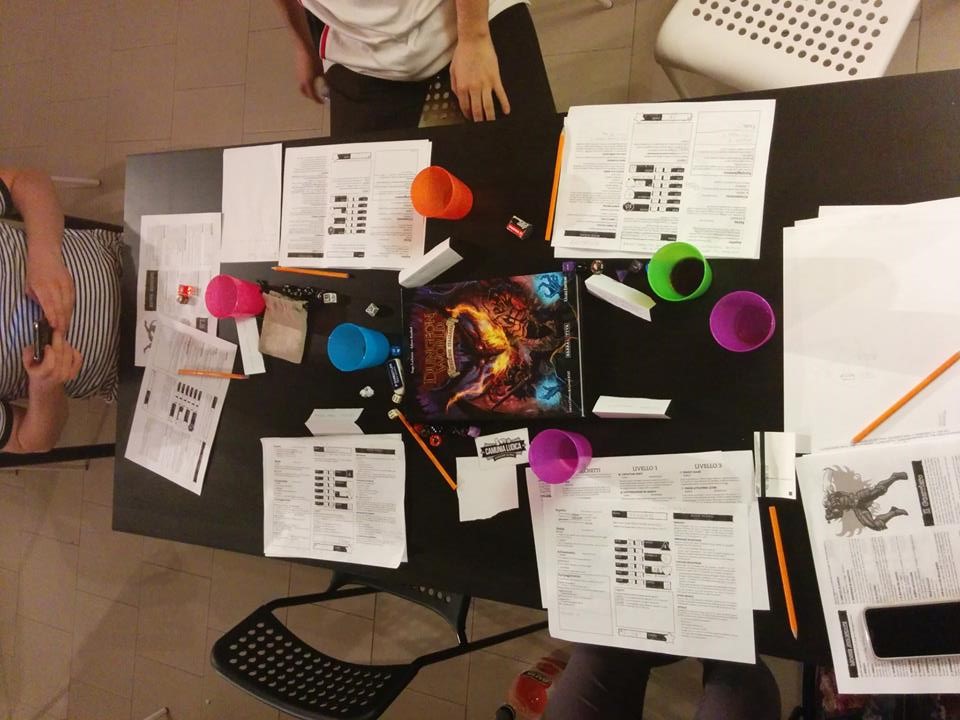Le responsabilità dei designer
Nel precedente intervento ho parlato delle responsabilità e dei limiti dell'editoria legata ai gdr, lato editori (sempre precisando che si tratta di miei pensieri).
Nell'aggiornamento cercherò di essere più breve, una cosa che riguarda i designer le loro responsabilità.
La prima cosa che mi viene in mente è che negli anni ci sono stati parecchi designer molto creativi e sto pensando a Greg Stafford (Sia per Pendragon che per Hero Wars), a Jonathan Tweet e Robin Laws (entrambe autori di Over the Edge), ; ma, quello che ho notato, almeno fino all'arrivo di the forge (come movimento) è stato esattamente un impegno imperioso in due direzioni:
1) tentare di creare dei sistemi di regole di gioco che, in buona sostanza, fossero i "motori grafici" (intendendoli come vero e proprio motore grafico di un videogioco), utilizzando variabili, tabelle e dadi come parte randomica;
2) creare dei "contesti/ambientazioni" immaginifiche che stuzzicassero la fantasia dei lettori come attività primaria.
Ecco. In due punti i limiti stessi dell'approccio.
Nel primo caso i sistemi di gioco spesso si trovavano mancanti delle vere regole del gioco: quelle che spiegano ai giocatori come interagire.
Ho avuto modo di avere un estenuante discussione in merito, anche al raduno è stato difficile parlare della cosa.
Sarò più esplicito nel mio blog.
E' un gioco dove nessuno vince e non ci sono regole
A mio avviso questa frase e le successive scalate in doppiacorda sugli specchi sono la riprova dell'assurdità dell'affermazione.
Se è un gioco le regole ci sono. Bisogna capire quali sono quelle vere, quelle che ogni gioco ha, quelle che dicono ai giocatori cosa fare e come farla, in "qualitateste" sarebbero procedure e istruzioni operative.
Queste cose, in molti giochi della vecchia scuola non ci sono proprio.
I manuali sembrano parlare a gente che ha già giocato o che è già stata introdotta, in qualche misura ad un mistero.
Ecco, questo genere di cose le attribuisco ai designer, semplicemente perché il loro compito, come creatori di giochi era di spiegare come il loro gioco funzionasse.
In questo contesto poi ho trovato molto peggiori sicuramente coloro che, consciamente o meno, hanno incoraggiato pratiche poco utili o, a mio avviso, dannose al gioco, come il barare, il fare railroading, o altre tecniche simili.
Insomma il gioco di ruolo era quello, molto meglio concentrarci sulle ambientazioni fighe. Ambientazioni destinate a lettori e collezionisti.
The forge, pur essendo nato per altri scopi, è stato un luogo di riflessione sul gioco, estremamente scevro da supercazzole, anche e sopratutto grazie a Ron Edwards, che ha costantemente "aggrato" coloro che avevano un approccio vago, di giochi fighi, da The forge ne sono usciti, ne sono usciti anche giochi per me pessimi (Shock), oppure incompleti (vedi l'inserzione precedente rispetto a FIASCO), il big model, per ora rimane l'unico strumento di analisi del gioco di ruolo che si ha, ma c'è un ma.
Per rispondere al "ma" mi limito a riportare di seguito un link, e con questo abbiamo concluso.
Il link è questo: http://apocalypse-world.com/forums/index.php?topic=7400.0
Il forum è Barf Forth Apocalyptica, forum dove Vincent Backer (autore di Cani nella Vigna e Apocalypse World ) discute dei suoi giochi, dei derivati dei suoi giochi (i PbA) e parla anche di teoria. Lumpley è il nick di backer
Per i pigri copio e incollo:
You've mentioned elsewhere that you feel it's time to put some of the Big Model in the dirt, and to move on to better ways to understand games.
What was the turning point, in your mind, on this topic? When did you start feeling this way and why?
How much of it is a problem with the Model itself, and how much of it is a problem with the conversations it generates?
So the Big Model is full of little taxonomies, right?
DFK. People said, "what about [this rule], is it D, F, or K?" The correct answer is: who cares? D, F and K are obviously just placeholders for the interesting thing to examine, which is the actual working of the rule itself.
Now, DFK is trivial, so it was easy to realize the correct answer. People only bothered to ask for about a month, and then everybody realized the correct answer and nobody asked after that.
IIEE. People said, "what about [this rule], is it II*EE, IIE*E, or what?" The correct answer is: who cares? I, I, E and E are obviously just placeholders for the interesting thing to examine, which is the actual working of the rule itself.
FitM/FatE. People said, "what about [this rule], is it FitM or FatE?" The correct answer is: who cares? FitM and FatE are obviously just placeholders for the interesting thing to examine, which is the actual working of the rule itself.
Stances. People said, "what about [when I did this], was it Actor Stance, Author Stance, or Director Stance? Or maybe Pawn Stance?" The correct answer is: who cares? the stances are obviously just placeholders for the interesting thing to examine, which is what you actually did.
Authorities. People said, "what about [when I did this], was I exercising Content Authority, Backstory Authority, or what?" The correct answer is: who cares? That list of "authorities" is obviously just a placeholder for the interesting thing to examine, which is what you actually did. (And furthermore, casting it as a question of authority in the first place is a bad idea. It's the worst idea in RPG thoery. Yes, worse than "if the GM can't arbitrarily kill any PC with no warning, it's not really an RPG," or any other bad idea you care to mention.)
For a long, long time, maybe embarrassingly long, I thought that GNS was an exception. That G, N, and S were "observed," true categories of play. I'd say things like "you know how most of the taxonomies in the Big Model are just, like, placeholders for the interesting things? GNS is the exception. G, N, and S are for real."
But one day, maybe 4-5 years ago, I caught myself, and said, "self, are you positive?"
And I concluded that when people say, "what about [this time we played], was it G, N, or S?" the correct answer is: who cares? That list of creative agendas is obviously just a placeholder for the interesting thing to examine, with is the actual working of that time you played.
Interpreting it into a box is not the same as understanding it, and, in fact, might be the opposite of understanding it.
So that was the turning point for me.
I'm saying that the model itself is obsolete. It is 100% about the Big Model itself.
-Vincent





4 Commenti
Commento consigliato
Crea un account o accedi per commentare
Devi essere un utente registrato per poter lasciare un commento
Crea un account
Crea un nuovo account e registrati nella nostra comunità. È facile!
Registra un nuovo accountAccedi
Hai già un account? Accedi qui.
Accedi ora